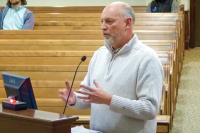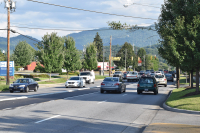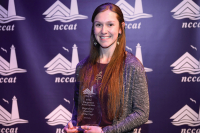The bicycle puzzle: Exploring opportunities of cycling tourism
 For the past few years, the Blue Ridge Breakaway has lured cyclists to Haywood for a ride through the mountains. The big attraction is the sweeping views to be had along the route.
For the past few years, the Blue Ridge Breakaway has lured cyclists to Haywood for a ride through the mountains. The big attraction is the sweeping views to be had along the route.
“They’re wanting to get up on the Parkway,” explained Melissa Tinsley, who coordinates events for the Haywood County Chamber of Commerce and is charged with the logistics of the annual Breakaway.
There’s also another pretty big attraction. “Tater-mater” sandwiches.
“We’re well known for having the best rest stops,” Tinsley said.
Along the cyclists’ routes there are stations providing food and drink to the riders. Using potato bread from City Bakery in Waynesville and tomatoes from Duckett’s Produce, Tinsley arms volunteers with tomato sandwiches. They’re graced with mayonnaise and salt and pepper. And the cyclists love them.
“The little Southern hospitality twist that we have up on our rest stops has gotten us the reputation for having the best rest stops with the sweetest volunteers,” Tinsley said.
Related Items
The Breakaway is Haywood’s big cycling event. A one-shot annual trick as far as the area’s overall tourism economics are concerned. But there’s an effort afoot to explore cycling’s tourism potential for the area. Perhaps there’s a market to be welcomed and nurtured.
This fall, a collective of participants — cyclists, local governments, the business community — began assessing the possibilities. They are trying to gain an accurate picture of the area’s assets and hurdles when it comes to cycling tourism, and to figure out how to better provide for and capitalize on the niche market.
“I think things like [the Blue Ridge Breakaway] have shown that Haywood County and our region has great potential to attract cyclists,” said George Ivey, a member of Bicycle Haywood NC. “So we want to expand on that.”
An emerging market
Earlier this year, Ivey and Jennifer Jacobson, another Haywood cyclist and fellow member of Bicycle Haywood N.C., worked to secure grant funding for a study looking at the area’s cycling tourism potential.
“Basically, we’re developing a cycling tourism plan for Haywood County and counties to the west,” Jacobson said.
The pair got funding from the Haywood County Tourism Development Authority and the Southwestern Commission. The roughly $10,000 study got started in October.
“I think it’s an emerging market for us,” said Lynn Collins, executive director of the Haywood TDA.
It’s not the first time Jacobson and Ivey have helped launch a cycling initiative. In 2011 they were instrumental in the process that resulted in a comprehensive bicycle plan for Haywood.
“We have the Haywood County Bicycle Plan,” Jacobson said, “but it wasn’t tourism specific.”
Unlike the previous project, this current effort explores beyond Haywood’s borders. That was a stipulation of the Southwestern Commission.
“We want the result of this study to be tools that anybody in the region can use if they want to get into the bicycle tourism game,” said Sarah Graham, director of planning and development with the Southwestern Commission.
The study began in early October, with a community workshop at the Haywood County Ag Center. Attendees were asked to help identify assets the region has for attracting cyclists and what strategies could be developed to create and grow cycling-related economic development.
“Very informative, lots of good ideas,” Collins reflected. “I’ll be anxious to see the report.”
The workshop was led by planning consultant Don Kostelec of Kostelec Planning in Asheville. He’s familiar with the area, having worked on the Haywood bicycle plan.
“One of the recommendations was to take a closer look at cycling tourism,” Kostelec said of Haywood’s comprehensive plan.
Imagining the possibilities
It’s early November and Kostelec is in California. He’s been biking in Coronado.
“I’m out here for a bicycling tourism conference,” Kostelec said over the phone, relishing the West Coast weather. “There are worse places to be than San Diego in November.”
Currently, the planner is compiling the information gathered during the October workshop. He’s hoping to have something ready to present to the community in December.
Kostelec breaks the study down into different components. It will examine how cycling tourism is working for other areas, it will take a look at how the local community can better cater to cyclists and it will attempt to define how the region can best accommodate cycling tourism.
“We’ll have a draft report sometime between now and Christmas,” Kostelec said.
During the October workshop, attendees were introduced to various aspects of cycling tourism. They learned about varying types of bicycle tourists — ranging from mountain bikers and road cyclists to families looking for a mellow loop — and what each was looking for in a cycling-centric destination. They learned about areas that seemed to be onto something — like the Route of the Hiawatha on the Montana-Idaho boarder and Oregon, with its Oregon’s Scenic Bikeways trail.
“Oregon has just been gangbusters,” Kostelec said.
Attendees were also educated about the importance of fostering a cycling-friendly culture. The possibility of installing wayfaring signage to direct cyclists around the area was discussed. There was also talk of the need for more bike racks and the possibility of lodging establishments coordinating shuttles to return touring cyclists back to the Blue Ridge Parkway after a night’s rest.
“Just trying to build that local culture is a piece,” Kostelec said.
The economic impact of cycling tourism was also discussed. For a living, breathing example, Kostelec held up the Blue Ridge Breakaway.
Estimating that the event drew nearly 600 people to the area, the math was worked out to indicate a total netting of more than $127,000 in tourism dollars.
Those numbers don’t surprise Ivey. He thinks the Breakaway could be just the tip of the iceberg.
“That’s just a nice little example of how successful it can be,” Ivey said.
A piece of the puzzle
Folks like Ivey aren’t surprised that cycling can generate money, because they’ve seen it happen. In fact, they’ve been the ones pumping money into such areas.
“I actually just did an event called Cycling North Carolina, which goes from the mountains to the coast every year,” Ivey said.
Traveling through communities hosting such events, Ivey has become the theoretical cycling tourist currently being pursued in Haywood. He recalls the locales along his cycling ventures fondly.
“One place made T-shirts for all of us,” he said. “They find places for people to camp.”
In addition to that state-crossing ride — also called the Mountains-to-the-Coast ride — Ivey recently participated in the Mountain Ride, a new event at Lake Lure.
“That was in Lake Lure, but that could be based in Haywood County, Maggie Valley or Cullowhee.”
Jacobson agrees. The area is ripe for such events.
“Pretty much we already have a great destination as far as scenery goes and we already have a great destination as far as trails to ride on,” Jacobson said. “But some of the infrastructure is missing.”
That missing infrastructure includes simple things like signs identifying trails and an education campaign to ensure that businesses, the community and, especially, drivers are more accommodating to cyclists. That infrastructure could mean designated routes with accompanying maps. That infrastructure could also include the installation of additional trails, or linking existing routes to allow cyclists to flow between communities.
“Right now, we have all the resources that people want. It’s beautiful, it’s got great places to stay,” said Kent Cranford, owner of Motion Makers Bicycles in Asheville and Sylva. “The natural structure is in place.”
Cranford notes that the area does have challenges. Communities in the area are still a bit of a ride off the Blue Ridge Parkway. Haywood, in particular, is lacking in mountain biking trails. And some people don’t feel safe cycling on the area’s roads.
But, all in all, the bike store owner sees the region slipping easily into the role of cycling tourism destination.
“It’s really exciting,” Cranford said.
Cranford points to areas that are currently capitalizing on cycling and hopes Western North Carolina can figure out the formula.
“Look at places like Damascus, Virginia, and the Virginia Creeper Trail, or look at places like Greenville, South Carolina, and the Swamp Rabbit [Trail],” Cranford said.
Kostelec knows that something as ambitious as the Virginia Creeper Trail — a 34.4-mile trail along an abandoned railroad, beginning in Abingdon, Virginia, and ending just past Whitetop Station at the Virginia-North Carolina border — isn’t something that is likely to happen anytime soon. That type of project would require a wealth of planning and coordination between neighboring communities and state-level agencies.
“I think that should be a long-term goal,” Kostelec said, adding that if such a rail-to-trail project were targeted in the area, there’s a stretch of rail between Murphy and Andrews that could be a candidate.
The consultant thinks cyclists and factions behind the current push to explore cycling tourism should concentrate on the more immediate. He thinks they should be looking to shift to a more cycling-friendly culture and work to identify and capitalize on existing opportunities for the cycling communities.
Small steps, or pedal rotations, could end up producing a solid component to the region’s overall tourism purse.
“It assists us with creating a diverse tourism economy by giving us more to add to our product mix,” said Ken Howle, who is director of advancement at Lake Junaluska, a member of Haywood’s TDA and a cyclist.
“It’s still just a percentage of what the overall tourism base is,” agrees Kostelec.
Not a drive-in, drive-out crowd
The array of cyclists communities seek to attract runs the gamut. There are crunchy mountain bikers spending their days getting thrown over handlebars in the backcountry. There are spandex-clad road bikers whizzing past on the roadways. There are casual travelers who’d enjoy taking the bike off the car and going for a relaxing spin.
“You can capture so many different types of people,” said Andrew Bowen, town planner for Maggie Valley.
Western North Carolina is looking to attract all these varying shades of cyclists.
“They can be people that like mountain biking dirt trails, or it can be more traditional road bikers,” said Ivey. “It can be families looking for a few miles of trail they can take their kids on.”
Ivey points to a style of biking that combines aspects of mountain biking and road cycling. He thinks the area could well cater to it.
“Gravel road cycling is starting to take off as well, and that’s sort of untapped,” Ivey said. “We’ve got lot of great dirt roads all around the county.”
Whatever the variety of cycling, it’s assumed the corresponding cyclist will bring their tourism dollars to town when they come to ride the area’s offerings.
“They’ll come and spend money, they’ll stay in lodges, they’ll eat in restaurants,” said Cranford. “This is not a drive-in, drive-out crowd.”
A tangible example of the impact cycling tourism offers can be seen in organized cycling events that draw in visitors specifically to ride their bike. Haywood already has such an example with the Blue Ridge Breakaway.
This year’s sixth annual event attracted more than 400 cyclists. Each likely traveled with family or friends.
“They come from Tennessee, South Carolina, Georgia, Alabama, Florida,” Tinsley rattled off. “It’s pretty neat. The cycling community is huge.”
But the Blue Ridge Breakaway is but once a year. How does the area pull that off repeatedly? How can it attract the varying degrees of cycling tourists throughout the year? And how can it best accommodate them?
That’s the puzzle currently being pursued in Haywood.
“We see a lot of untapped potential there,” said Ivey.
The Damascus dream
The current project focused on cycling tourism in Haywood County and the surrounding areas is striving to add to the region’s economic pie. For other areas, cycling tourism has played a more crucial role.
“It has the capability to take communities that were shutting up their doors and closing up businesses and turning them into newly thriving communities,” said Kent Cranford, owner of Motion Makers Bicycles in Sylva and Asheville.
Case in point: Damascus, Va.
Damascus was a former timber town. There was also once some manufacturing. But more recently, times were lean.
Then came the Virginia Creeper Trail, a 34.3-mile trail along abandoned railroad tracks. The trail begins in Abingdon, Va., and traverses through Damascus before winding past Whitetop Station at the Virginia-North Carolina border.
“That’s the only thing that saved the town, to be honest with you,” said Carlton Baker, an assistant manager with Adventure Damascus. “It’s not even close.”
The store is among a half dozen in the small town that cater to the trail and its visitors. They rent bikes and sell cycling gear. They run shuttles to the trail and back.
Each year, the scene gets better.
“As far as people coming to ride the trail, this has been our best year,” Baker said, estimating that his business alone has shuttled about 11,000 cyclists to the trail this year.
Different strokes for diffferent folks
When an area attempts to jump in the cycling tourism game, it needs to speak to a number of different types of cyclists.
“When you say ‘bicycle tourism’ you just don’t think spandex-clad cyclist with a $10,000 bike,” said planning consultant Don Kostelec.
During an October workshop focused on upping the area’s cycling tourism game, Kostelec laid out the various types of cyclists the tourism market should be aiming to attract.
Mountain or cyclocross
• Look to escape the confines of roads and paved trails.
• Seek off-road, unpaved trails in mountainous areas.
• Generally reach their destination by motor vehicle but are seeking non-motorized pathways to travel from lodging/camping to the trail.
• May ride for several hours on mountain bike loops and on multi-day excursions.
Low-stress or family bicyclists
• Seek short–to-medium-range riding distances (10 to 30 miles) for roundtrip, point-to-point or multi-day rides on multi-use trails.
• Seek scenic routes that offer separation from high-stress or on- street facilities.
• Bring their bike with them on vacation in hopes of finding recreational trails and will ride with children, friends and family.
• May pick destinations or side trips along the route to see, eat or recreate.
Touring Bicyclists
• Ride on multi-day trips from point to point or in large loops (hundreds of miles).
• Seek scenic routes and try to avoid high-stress routes in urban areas.
• Generally travel by car, train or plane to reach a starting point before embarking on a multi-day trip.
• May ride with a “support vehicle” or in a group with support.
• Some companies organize bicycle touring vacations and excursions.
Recreational bicyclists
• Ride on 30-, 50-, or 100-mile loops in a day and may do this with a group, a spouse/partner or friends.
• Seek scenic routes and try to avoid high-stress routes in urban areas.
• Bring their bike with them on vacation in hopes of finding recreational loops.
• Will seek cue sheets from local bike clubs to identify rides.
• May pick destinations along the route to see, eat or recreate.









